Lesser Horseshoe
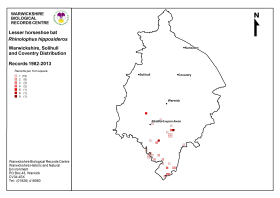
Distribution map for Lesser Horseshoe bats in Warwickshire. (Click for a full sized image)
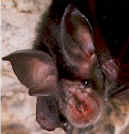 The
Lesser Horseshoe is one of our smallest British species. At rest it hangs
with the wings wrapped around the body and is about the size of a plum.
Like the Greater Horseshoe bat, it has a complex noseleaf which is related
to its particular type of echolocation system. Instead of using their larynx
to produce sonar they use their nose and emit a 90 degree cone of ultrasound
through their noseleaves.
The
Lesser Horseshoe is one of our smallest British species. At rest it hangs
with the wings wrapped around the body and is about the size of a plum.
Like the Greater Horseshoe bat, it has a complex noseleaf which is related
to its particular type of echolocation system. Instead of using their larynx
to produce sonar they use their nose and emit a 90 degree cone of ultrasound
through their noseleaves.
Like the Greater Horseshoe bat, this species has shown a marked decline
in numbers and distribution particularly in western and northern Europe
although there is evidence of a recent increase in some areas. The Lesser
Horseshoe bat is rare in the British Isles and is confined mainly to Wales,
western England and western Ireland.
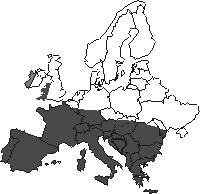 However
there is some good news - the BCT's NBMP
(National Bat Monitoring Programme) reported in January 2001 that Welsh
populations have increased by a rate of 6.2% per annum in the years 1993
to 1999. Overall the UK population has risen by 4.8% over the same period,
but the English population may be increasing very slowly or even declining.
It is thought that their success in Wales is due to the preservation
of hedgerows and other wildlife corridors, the amount of traditional pasture
available and less intensive farming practices.
However
there is some good news - the BCT's NBMP
(National Bat Monitoring Programme) reported in January 2001 that Welsh
populations have increased by a rate of 6.2% per annum in the years 1993
to 1999. Overall the UK population has risen by 4.8% over the same period,
but the English population may be increasing very slowly or even declining.
It is thought that their success in Wales is due to the preservation
of hedgerows and other wildlife corridors, the amount of traditional pasture
available and less intensive farming practices.
 The decline of the Lesser Horseshoe bat is attributable to several factors
including disturbance to roosts and intensive agricultural practices.
Lesser Horseshoe bats are particularly sensitive to disturbance especially
of their nursery and winter roosts. These sites need to be specifically
protected and entrance holes left unobstructed. The conservation of their
feeding habitats and food sources is of paramount importance. The use
of pesticides has probably led to a decrease in their available food source.
The decline of the Lesser Horseshoe bat is attributable to several factors
including disturbance to roosts and intensive agricultural practices.
Lesser Horseshoe bats are particularly sensitive to disturbance especially
of their nursery and winter roosts. These sites need to be specifically
protected and entrance holes left unobstructed. The conservation of their
feeding habitats and food sources is of paramount importance. The use
of pesticides has probably led to a decrease in their available food source.
flight & ultrasound

In the summer months Lesser Horseshoe bats emerge about half an hour
after sunset as it is getting quite dark The emergence follows a period
when the bats fly around within the roost with some appearance outside
the roost entrance; presumably they are testing the conditions outside
before emergence. Although there are peaks of activity at dusk (and also
at dawn) bats are active all night throughout the breeding season. Lesser
Horseshoe bats are sensitive to disturbance and twist their bodies as
they scan their surroundings before flying off.
 Lesser
Horseshoe bats feed amongst vegetation in sheltered lowland valleys. They
fly close to the ground, rarely more than 5m high, with frequent circling
over favoured areas and often 'gleaning' their prey off stones and
branches. Large prey is often taken back to a temporary night roost or
sometimes dealt with whilst hanging in trees. Feeding remains are found
in such places, particularly in porches and the entrance to tunnels.
Lesser
Horseshoe bats feed amongst vegetation in sheltered lowland valleys. They
fly close to the ground, rarely more than 5m high, with frequent circling
over favoured areas and often 'gleaning' their prey off stones and
branches. Large prey is often taken back to a temporary night roost or
sometimes dealt with whilst hanging in trees. Feeding remains are found
in such places, particularly in porches and the entrance to tunnels.
Lesser Horseshoe bats have an almost constant frequency call at about
110kHz. On a heterodyne bat detector a
series of continuous 'warbles' can be heard.
Horseshoe bats rely on the apparent change in frequency caused by the relative
movement of a sound source and receiver. This change called Doppler
shift, is the same phenomenon that appears to make the pitch of the
siren on an approaching police car grow higher as it approaches and then
deepen as it passes by. The Horseshoe bats compare the pitch that they emit
from their noses to that which returns to their ears. In this way they can
distinguish a stationary tree from a flying insect. So they are very insensitive
to the emitted frequency and exceptionally sensitive to frequencies just
above and below it.
 Lesser Horseshoe call on a Heterodyne bat detector
Lesser Horseshoe call on a Heterodyne bat detector
breeding
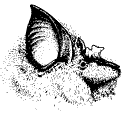 Mating
takes place during autumn, sometimes later. maternity roosts are almost
always formed in buildings and may be occupied from April, though most
breeding females do not arrive until May.
Mating
takes place during autumn, sometimes later. maternity roosts are almost
always formed in buildings and may be occupied from April, though most
breeding females do not arrive until May.
Maternity colonies of the Lesser Horseshoe bat are of mixed sex, with
up to a fifth of the colony being male. Approximately half to two-thirds
of the females in the nursery roost give birth to a single young between
mid-June and mid-July.
Lactation probably lasts four to five weeks, by which time the young
can fly from the roost. They are completely independent at six weeks and
nurseries disperse between August and October (occasionally November).
Most young are sexually mature in their second autumn.
summer roosts
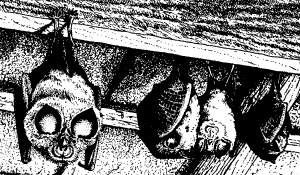 Lesser
Horseshoe bats were originally cave dwellers but summer colonies are now
usually found in the roofs of larger rural houses and stable blocks offering
a range of roof spaces and a nearby cellar, cave or tunnel where the bats
can go torpid in inclement weather. They prefer access through an opening
that allows uninterrupted flight to the roof apex but they are capable
of using more inconspicuous gaps. The colony may shift between attics,
cellars and chimneys throughout the summer depending on the weather. The
whole colony may form a dense cluster, especially in cooler weather during
lactation but if the roost gets very hot they hang spaced slightly apart.
Lesser
Horseshoe bats were originally cave dwellers but summer colonies are now
usually found in the roofs of larger rural houses and stable blocks offering
a range of roof spaces and a nearby cellar, cave or tunnel where the bats
can go torpid in inclement weather. They prefer access through an opening
that allows uninterrupted flight to the roof apex but they are capable
of using more inconspicuous gaps. The colony may shift between attics,
cellars and chimneys throughout the summer depending on the weather. The
whole colony may form a dense cluster, especially in cooler weather during
lactation but if the roost gets very hot they hang spaced slightly apart.
winter roosts
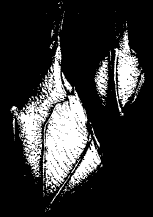
The Lesser Horseshoe bat uses caves, mines, tunnels and cellars as hibernation
sites. They hibernate from September or October until April and frequently
into May. Lesser Horseshoe bats are often active in the hibernacula in autumn
and spring especially towards dusk in warm weather when feeding is more
likely to be successful. They appear to select places with similar temperatures
to Greater Horseshoe bats, preferring temperatures of up to 11ºC and with
a high humidity.
Males tend to arrive earlier than females and are often more numerous.
Many sites only have one or a few bats hibernating in them and it is rare
to find large number in a site. Even when aggregated, Lesser Horseshoe
bats do not cluster but hang a little apart from their neighbours, usually
exposed but sometimes in open crevices. They may be found from almost
ground level to over 20m and venture much further into underground sites
than other bats.
| Description |
|
| Head and Body Length |
35 - 45 mm |
| Forearm Length |
35 - 42 mm |
| Wingspan |
200 - 250 mm |
| Weight |
5 - 9 g |
| Colour |
Adults pinky buff-brown, juveniles greyish (until first
summer after birth). |
|
|
| |
|
| Life Cycle |
|
| Mating Period |
September to November. |
| Maternity Colonies |
Established late spring.
Young: 1 born mid-June to mid-July, weaned at 6 weeks. |
| Colony Size |
30 to 70 bats (occasionally 400). |
| Longevity |
Up to 21 years. |
| UK Status |
Endangered. |
|
|
| |
|
| Habitat and Food |
|
| Summer Roosts |
Originally cave dwellers, now roofs of larger houses
and stable blocks. |
| Winter Roosts |
Caves, mines, tunnels, cellars. |
| Feeding Habitat |
Open deciduous woodland, scrub, parkland, wetland and
permanent pasture. |
| Food |
Flies (mainly midges), small moths, caddisflies, lacewings, beetles,
small wasps, spiders.

|
further reading
Dietz C, Dietz I and Siemers BM: Wing measurement variations in the five
European horseshoe bat species (Chiroptera: Rhinolophidae). Journal of
Mammalogy, (2006).
Dietz C, Dietz I and Siemers BM: Growth of horseshoe bats (Chiroptera:
Rhinolophidae) in temperate continental conditions and the influence of
climate. Mammalian Biology, (2006).
Dietz C, Dietz I, Ivanova T and Siemers BM: Movements of horseshoe bats
(Rhinolophus, Chiroptera: Rhinolophidae) in Northern Bulgaria. Myotis,
(2006).